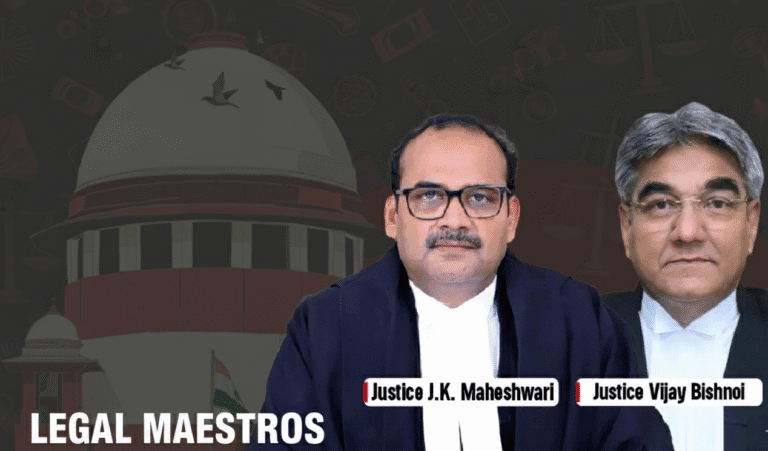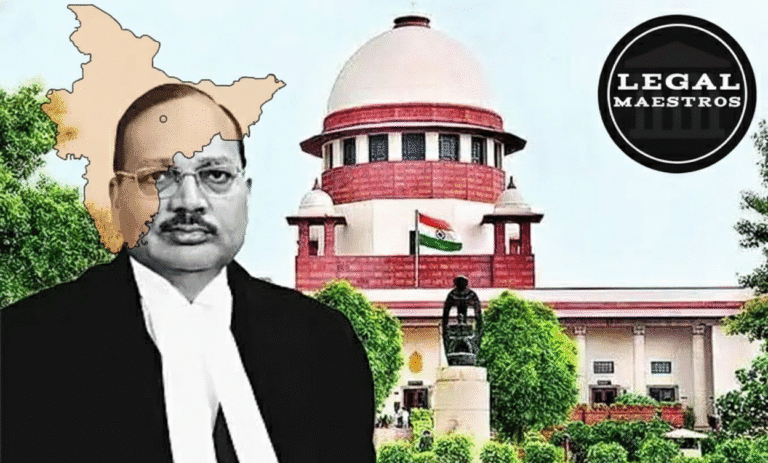
Supreme Court Justice Surya Kant Delivers Landmark Verdict Upholding Khajuria Tank Park in Public Trust Doctrine Case
Introduction
A public interest writ petition was filed by the Municipal Corporation of Greater Mumbai (MCGM) over the rehabilitation of a lake that was constructed one hundred years ago into a recreational park. On May 30, 2025, the Supreme Court of India issued its decision in the appeal that was brought about by the case.
if the transformation of an alleged natural water body into an urban garden should be undone, therefore restoring the lake, or if the present park should be preserved in light of its demonstrated public usefulness, the Court was asked to make a decision about whether or not the lake should be restored.
Questions about the use of land, the protection of the environment under the Constitution, the extent of the public trust theory, and the possibility of taking corrective action after the passage of time were major considerations in the decision-making process.
For any queries or to publish an article or post or advertisement on our platform, do call at +91 6377460764 or email us at contact@legalmaestros.com.
For More Updates & Regular Notes Join Our Whats App Group (https://chat.whatsapp.com/DkucckgAEJbCtXwXr2yIt0) and Telegram Group ( https://t.me/legalmaestroeducators )
Background of the Dispute
Initially registered in revenue records as a State Government property, the Khajuria Lake, which is thought to be over one hundred years old, was known to be located on a block of land located at Khajuria Tank Road in Kandivali (West), Mumbai.
This land was the source of the dispute. Alleging that the lake had been abandoned and was being used as a rubbish dump, the Municipal Corporation of Greater Mumbai (MCGM) issued a tender in 2008 and engaged M/s. Techno Trade Impex India Pvt. Ltd. to transform the property into a theme garden.
For any queries or to publish an article or post or advertisement on our platform, do call at +91 6377460764 or email us at contact@legalmaestros.com.
This was done in response to an order to beautify different municipal plots. Despite the fact that the site was owned by the Collector, the Municipal Corporation of Greater Mumbai (MCGM) continued with the construction, obtained clearance from the budget for a sum of five crores of rupees, and presented the recreational park to the public in December of 2011.
An person with a strong commitment to public service was motivated to submit a writ petition about the destruction of the park and the restoration of the lake after reading a news story in September of 2012.
In August of 2018, the petition was granted by the High Court of Bombay, which ordered the lake to be demolished and restored. MCGM filed an appeal with the Supreme Court, which stayed the ruling issued by the High Court in November of 2018, and will hold a new hearing on the topic in 2025.
For any queries or to publish an article or post or advertisement on our platform, do call at +91 6377460764 or email us at contact@legalmaestros.com.
Legal Provisions Considered
The United States Supreme Court focused its attention on a number of constitutional and legislative concerns. A responsibility to maintain and develop the environment, as well as to safeguard forests and animals, is imposed on the state by Article 48A of the Constitution and on every person by Article 51A(g) of the Constitution.
Certain natural resources, such as bodies of water, are held in trust by the state for the purpose of public use, and the public trust doctrine maintains that these resources cannot be alienated or destroyed. This concept was developed via court rulings.
Additionally, the Court looked into the approved Development Plan from 1991, which designated the Subject Property as a “Recreation Ground” (also known as a “R.G.”). This was done in response to the required public consultation that took place in 1984, as well as the obligation that the Municipal Corporation had to provide park and recreational areas.
For any queries or to publish an article or post or advertisement on our platform, do call at +91 6377460764 or email us at contact@legalmaestros.com.
A post facto penalty that was issued by the Collector in February 2014 was also taken into consideration, particularly its rider that banned any future changes in land use. The legitimacy and consequences of this punishment were also taken into consideration.
Contentions of the Municipal Corporation
In the sanctioned Development Plan, the MCGM, which was represented by Senior Counsel Mr. Dhruv Mehta, claimed that the Subject Property had been legitimately designated as a recreational field. This designation was done after the appropriate public notice was given and without any objections being raised.
The company contended that the lake, which had been utilized in the past, had turned into a dumping site that was unsanitary and without any biological value since it had been abandoned. The project, as stated by MCGM, considerably improved public welfare by establishing a green urban oasis that had mature trees, a musical fountain, and facilities for sports and leisure activities that were accessible to people of all ages and did not need registration.
For any queries or to publish an article or post or advertisement on our platform, do call at +91 6377460764 or email us at contact@legalmaestros.com.
A decrepit property was transformed into a flourishing public amenity, and MCGM argued that the High Court made a mistake by failing to recognize the legislative foundation for its action and the alteration of the land. In addition, the company argued that the restoration order issued by the High Court would result in the unjustifiable destruction of the park as well as the disappearance of a significant amount of public investment.
Contentions of the Petitioner
Through the assistance of Mr. Kunal Cheema, the petitioner, Pankaj Babulal Kotecha, argued that the evidence conclusively established the historical presence of Khajuria Lake as well as its ecological significance.
He cited to a letter sent by the Municipal Corporation of Greater Mumbai (MCGM) in June 2009, which said that the lake had been “converting the Khajuria Talao to that of a municipal garden.” This was an acknowledgment that the lake had previous existence.
For any queries or to publish an article or post or advertisement on our platform, do call at +91 6377460764 or email us at contact@legalmaestros.com.
It was underlined by the petitioner that the lake serves as a home for fish, tortoises, birds, and mangroves in the surrounding area, all of which are purportedly destroyed by the construction taking place.
In addition to highlighting the environmental and public trust requirements that, according to him, mandated the rigorous protection of natural water bodies without exception, he questioned the legitimacy of the post facto sanction that was implemented in 2014, arguing that it was an invalid effort to retroactively legalize a conduct that had not been approved.
Fundamental Issues for Determination
First, whether the Subject Property ever constituted a functional water body with ecological significance at the relevant time; second, whether the transformation into a recreational park violated the State’s obligation under the public trust doctrine and constitutional environmental duties; and third, whether, in light of the passage of fifteen years, the scope and desirability of restoring the original water body justified reversing the development.
For any queries or to publish an article or post or advertisement on our platform, do call at +91 6377460764 or email us at contact@legalmaestros.com.
The Supreme Court identified these three primary issues as the fundamental issues that needed to be addressed. The larger difficulty of balancing the preservation of the environment with the ever-changing requirements of public welfare in the context of rapidly urbanizing an area was the driving force behind these concerns.
Analysis by the Supreme Court
The Court noted the significant role that the public trust concept plays in environmental law; nonetheless, it ruled that its application must be weighed against the actual realities and conditions that have evolved over time. Affidavits and photographs indicated that the site had degenerated into an unused dumping ground with no natural catchment or ongoing ecological functions.
The Court found that the material on record did not establish the existence of a functional pond at the time of development. This was the first factor that the Court discovered. The Court made the observation that the park had developed into a lush urban oasis that was an essential part of the community over the course of almost fifteen years.
For any queries or to publish an article or post or advertisement on our platform, do call at +91 6377460764 or email us at contact@legalmaestros.com.
This was in reference to the existing ecological value. There were safe recreational facilities for children, areas for exercise and social contact for elders, and community meeting spots for families. The trees that had been planted had grown greatly, which contributed to the purification of the air and the management of the microclimate.
According to the decision of the court, the destruction of the park would result in direct damage to the environment since it would include the removal of mature trees and the waste of public dollars on investments.
In addition, the reconstruction of a pond that does not have a natural water supply would most likely result in a body of water that is stagnant and susceptible to illnesses that are transmitted by vectors, which would result in the failure of ecological goals. Regarding the post facto punishment, the Court made the observation that, despite the fact that the 2014 approval’s rider included procedural flaws, it protected the property’s commitment to recreation in perpetuity, so insuring that there would be no subsequent diversion.
For any queries or to publish an article or post or advertisement on our platform, do call at +91 6377460764 or email us at contact@legalmaestros.com.
Last but not least, the Court underlined the excessive delay in contesting the construction, which was submitted years after the park had been completed. This delay had established the park’s existence and public dependence, so establishing an irreversible status quo that made restoration both difficult and adverse to the public interest.”
Conclusion and Directions
As a result of the Supreme Court’s decision to grant the appeal, the High Court’s restoration order was overturned. The Supreme Court came to the conclusion that the preservation of the current park was in the greatest interest of ecological balance and public welfare.
It was ordered by the court that the park be preserved as a green area that is only for the benefit of the general public and does not have any substantial commercial activity. Furthermore, it instructed the corporation to establish an expert committee within three months to investigate the possibility of developing an alternative water body in the vicinity, to undertake ecological restoration of other water bodies that had deteriorated within a year, and to meet with the High Court every six months for a period of three years in order to comply with the mandate.
For any queries or to publish an article or post or advertisement on our platform, do call at +91 6377460764 or email us at contact@legalmaestros.com.
A sophisticated approach to sustainable city planning and the growing application of constitutional environmental obligations is reflected in the ruling, which represents the harmonisation of environmental principles with the requirements of urban growth.




![Research Assistantship @ Sahibnoor Singh Sindhu, [Remote; Stipend of Rs. 7.5k; Dec 2025 & Jan 2026]: Apply by Nov 14, 2025!](https://legalmaestros.com/wp-content/uploads/2025/11/Gemini_Generated_Image_s0k4u6s0k4u6s0k4-768x707.png)
![Karanjawala & Co Hiring Freshers for Legal Counsel [Immediate Joining; Full Time Position in Delhi]: Apply Now!](https://legalmaestros.com/wp-content/uploads/2025/11/Gemini_Generated_Image_52f8mg52f8mg52f8-768x711.png)
![Part-Time Legal Associate / Legal Intern @ Juris at Work [Remote]: Apply Now!](https://legalmaestros.com/wp-content/uploads/2025/11/ChatGPT-Image-Nov-12-2025-08_08_41-PM-768x768.png)
![JOB POST: Legal Content Manager at Lawctopus [3-7 Years PQE; Salary Upto Rs. 70k; Remote]: Rolling Applications!](https://legalmaestros.com/wp-content/uploads/2025/11/ChatGPT-Image-Nov-12-2025-08_01_56-PM-768x768.png)